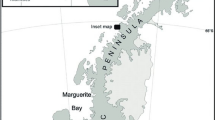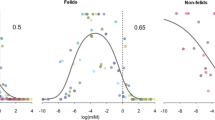Abstract
Prey occurrence from stomach and fecal samples were compared in American martenMartes americana Turton, 1806, and fisherM. pennanti Erxleben, 1777. Diets were analyzed from stomach and fecal contents in four sex-age marten groups and four fisher groups, and dietary differences tested between species, sex, age and sample sources. Prey richness was compared between the two sample sources. Relative occurrence of dominant or co-dominant prey items did not differ between stomach and fecal samples in any of the groups. However, both series revealed inter-specific contrasts. Binomial correlations of prey occurrence between sample sources were significantly negative for most prey items. Correlations of prey richness between samples sources were not significant except in larger marten sample. Our results failed to reveal a bias in using fecal sample source. Thus we suggest that diet analyses using either sample source are valid when diets are assessed in a relatively large number of animals.
Similar content being viewed by others
References
Casaux R. J., Favero M., Coria N. and Silva P. 1997. Diet of the imperial cormorantPhalacrocorax atriceps: comparison of pellets and stomach contents. Marine Ornithology 25: 1–4.
Cavallini P. and Volpi T. 1995. Biases in the analysis of the diet of the red foxVulpes vulpes. Wildlife Biology 1: 243–248.
Cobb E. W. 2000. Physical condition of American martens,Martes americana, from two forest regions in northeastern Ontario. MSc thesis, Laurentian University, Sudbury: 1–86.
Corbett L. K. 1989. Assessing the diet of dingoes from faeces-A comparison of 3 methods. The Journal of Wildlife Management 53: 343–346.
Cumberland R. E., Dempsey J. A. and Forbes G. J. 2001. Should diet be based on biomass? Importance of larger prey to the American marten. Wildlife Society Bulletin 29: 1125–1130.
Derby C. E. and Lovvorn J. R. 1997. Comparison of pellets versus collected birds for sampling diets of double-crested cormorants. Condor 99: 549–553.
Dix L. M. and Strickland M. A. 1986. Use of tooth radiographs to classify martens by sex and age. Wildlife Society Bulletin 14: 275–279.
Eybert M. C. and Constant P. 1992. Validity of fecal sac analysis for the study of nestling diet of the European linnet (Carduelis cannabina). Canadian Journal of Zoology 70: 2171–2177.
Gonzalez-Solis J., Oro D., Pedrocchi V., Jover L. and Ruiz X. 1997. Bias associated with diet samples in Audouin’s gulls. Condor 99: 773–779.
Goszczyński J. 1974. Studies on the food of foxes. Acta Theriologica 19: 1–18.
Greenwood R. J. 1979. Relating residue in raccoon feces to food consumed. American Midland Naturalist 102: 191–193.
Harris M. P. and Wanless S. 1993. The diet of shagsPhalacrocorax Aristotelis during the chick-rearing period assessed by three methods. Bird Study 40: 135–139.
Laurence S. 2002. Régime alimentaire hivernal de la martre d’Amérique,Martes americana, dans le centre-nord de l’Ontario. MSc thesis Laurentian University, Sudbury: 1–84.
Litvaitis J. A. 2000. Investigating food habits of terrestrial vertebrates. [In: Research techniques in animal ecology. Controversies and consequences. L. Boitani and T. K. Fuller, eds]. Columbia University Press, New York: 165–190.
Litvaitis J. A., Titus K. and Anderson E. M. 1994. Measuring vertebrate use of terrestrial habitats and foods. [In: Research and management techniques for wildlife and habitats. T. A. Bookhout, ed]. The Wildlife Society, Bethesda, Maryland: 254–306.
Lockie J. D. 1959. The estimation of the food of foxes. The Journal of Wildlife Management 23: 224–227.
Martin S. K. 1994. Feeding ecology of American martens and fishers. [In: Martens, sables, and fishers: Biology and conservation. S. W. Buskirk, A. S. Harestad, M. G. Raphael, and R. A. Powell, eds]. Cornell University Press, Ithaca: 297–315.
McInnis M. L., Vavra M. and Krueger W. C. 1983. A comparison of four methods used to determine the diets of large herbivores. Journal of Range Management 36: 302–306.
Nagorsen D. W., Forsberg J. and Giannico G. R. 1988. An evaluation of canine radiographs for sexing and aging Pacific coast martens. Wildlife Society Bulletin 16: 421–426.
Oksanen T. 1983. Prey caching in the hunting strategy of small mustelids. Acta Zoologica Fennica 174: 197–199.
Peters R. H. (ed) 1983. Ecological implications of body size. Cambridge University Press, Cambridge: 1–329.
Poole K. G., Matson G. M., Strickland M. A., Magoun A. J., Graf R. P. and Dix L. M. 1994. Age and sex determination for American martens and fishers. [In: Martens, sables, and fishers: Biology and conservation. S. W. Buskirk, A. S. Harestad, M. G. Raphael and R. A. Powell, eds]. Cornell University Press, Ithaca: 204–223.
Punta G., Yorio P. and Herrera G. 2003. Temporal patterns in the diet and food partitioning in Imperial cormorants (Phalacrocorax atriceps) and Rock shags (P. magellanicus) breeding at Bahia Bustamante, Argentina. Wilson Bulletin 115: 307–315.
Putman R. J. 1984. Facts from faeces. Mammal Review 14: 79–97.
Randall P. J. and Myers A. A. 2001. Effects of resource matrix, gut region analyzed and sample size on diet statistics in co-existing species of flatfish. Journal of the Marine Biological Association of the United Kingdom 81: 1041–1048.
Reynolds J. C. and Aebischer N. J. 1991. Comparison and quantification of carnivore diet by faecal analysis: a critique, with recommendations, based on a study of the Red foxVulpes vulpes. Mammal Review 21: 97–122.
Rodway M. S. and Cooke F. 2002. Use of fecal analysis to determine seasonal changes in the diet of wintering Harlequin Ducks at a herring spawning site. Journal of Field Ornithology 73: 363–371.
SAS Institute. 1995. JMP 3.2.2 for PC, Cary, NC 27513.
Simon N. P., Schwab F. E., LeCoure M. I. and Phillips F. R. 1999. Fall and winter diet of martens,Martes americana, in central Labrador related to small mammal densities. Canadian Field-Naturalist 113: 678–680.
Wydeven P. R. and Dahlgren R. B. 1982. A comparison of prairie dog stomach contents and feces using a microhistological technique. Journal of Wildlife Management 46: 1104–1105.
Zar J. H. (ed) 1999. Biostatistical analysis. Prentice-Hall, Upper saddle River, New Jersey: 1–663.
Author information
Authors and Affiliations
Corresponding author
Additional information
Associate editor was Andrzej Zalewski.
Rights and permissions
About this article
Cite this article
Robitaille, J.F., Laurence, S. More on the validation of fecal samples for the large-scale study of dietary differences between two sympatric carnivores. Acta Theriol 52, 307–315 (2007). https://doi.org/10.1007/BF03194227
Received:
Accepted:
Issue Date:
DOI: https://doi.org/10.1007/BF03194227




